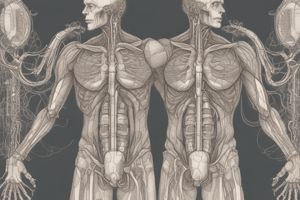Podcast
Questions and Answers
What is the primary function of the urinary system?
What is the primary function of the urinary system?
- To store nutrients for later use
- To regulate body temperature
- To produce hormones involved in bone growth
- To filter and eliminate waste products from the blood (correct)
Which of the following is NOT a function of the urinary system?
Which of the following is NOT a function of the urinary system?
- Storing energy for later use (correct)
- Producing hormones involved in red blood cell production
- Maintaining electrolyte balance
- Regulating blood pressure
What is the name of the tube that carries urine from the kidney to the urinary bladder?
What is the name of the tube that carries urine from the kidney to the urinary bladder?
- Nephron
- Renal pelvis
- Urethra
- Ureter (correct)
Where is the left kidney located in relation to the right kidney?
Where is the left kidney located in relation to the right kidney?
What is the name of the outermost layer that protects and stabilizes the kidney?
What is the name of the outermost layer that protects and stabilizes the kidney?
What is the name of the structure that receives urine from the papilla of one renal pyramid?
What is the name of the structure that receives urine from the papilla of one renal pyramid?
What is the percentage of total cardiac output received by the kidney?
What is the percentage of total cardiac output received by the kidney?
What is the name of the microscopic functioning unit of the kidney?
What is the name of the microscopic functioning unit of the kidney?
What is the name of the structure that empties into the collecting system?
What is the name of the structure that empties into the collecting system?
What is the function of the glomerular (Bowman's) capsule?
What is the function of the glomerular (Bowman's) capsule?
Flashcards are hidden until you start studying
Study Notes
Functions of the Urinary System
- The urinary system filters and eliminates waste products from blood
- It helps maintain electrolyte balance and regulate fluid levels in the body
- It contributes to blood pressure regulation
- It produces hormones involved in red blood cell production and calcium metabolism
Urinary System Organs
- Kidneys (two) produce urine
- Urinary tract consists of:
- Ureters that transport urine towards the urinary bladder
- Urinary bladder that temporarily stores urine prior to urination
- Urethra
Homeostatic Function of the Urinary System
- Regulates blood volume and blood pressure by adjusting the volume of water lost in urine
- Regulates plasma ion concentrations by controlling the quantity of sodium, potassium, chloride, and other ions lost in urine
- Calcium level is controlled through the synthesis of calcitriol
- Helps control blood pH by controlling the loss of hydrogen and bicarbonate ions in urine
- Conserves valuable nutrients by preventing their loss while removing metabolic wastes (e.g., urea and uric acids)
- Assists the liver in detoxification of poisons and deamination of amino acids during starvation
Kidney Structure
- Located on either side of the vertebral column, with the left kidney slightly superior to the right kidney
- The superior surface of the kidney is capped by the adrenal gland
- The kidney is positioned overlying the peritoneum, in the back of the abdominal cavity, and supported by connective tissue
- Attached to the aorta and inferior vena cava
- Blood enters the kidney through the renal artery and leaves through the renal vein
- Each kidney is enclosed in a renal capsule surrounded by adipose tissue
Internal Kidney Structures
- Renal cortex
- Renal medulla
- Renal pyramids
- Renal columns
- Minor and major calyces
- Renal pelvis
Protective Layers of the Kidney
- Fibrous capsule (layer of collagen fibers covering the outer surface of the entire organ)
- Perinephric fat (thick layer of adipose tissue surrounding the fibrous capsule)
- Renal fascia (dense fibrous outer layer anchoring the kidney to the surrounding tissue)
Kidney Functions
- Filters blood
- Produces urine
Adult Kidney Characteristics
- 10 cm long and weighing 150 grams
Hilum
- Prominent medial indentation
- Point of entry for the renal artery and renal nerves
- Point of exit for the renal vein and ureter
Renal Cortex
- Superficial region of the kidney in contact with the fibrous capsule
- Reddish-brown and granular
Renal Pyramid
- 6-8 triangular structures in the renal medulla
- Base of each pyramid abuts the renal cortex
- Tips (renal papilla) project into the renal sinus
Kidney Lobes
- Consist of renal pyramid, renal cortex, and renal columns
Ducts within the Renal Papilla
- Discharge urine into a minor calyx, a cup-shaped drain
Minor and Major Calyces
- Major calyces are formed by 4-5 minor calyces
- Minor calyces receive urine from the papilla of one renal pyramid
- Once the filtrate enters the calyces, it becomes urine because no further reabsorption can occur
Renal Pelvis
- Large funnel-shaped chamber
- Formed by 2/3 major calyces
- Connected to the ureter, which drains the kidney
Blood Supply to the Kidney
- Kidney receives 20-25% of total cardiac output
- About 1200 ml of blood enters each minute
- Receives blood from the artery
Nephron
- The microscopic functioning unit of the kidney, with each kidney having millions
- Consists of renal corpuscle (filtering blood plasma) and renal tubule (filtered fluid passes through)
- Renal tubule empties into a collecting system
Parts of the Nephron
- Renal corpuscle (spherical structure)
- Glomerular (Bowman's) capsule (outer wall of the renal corpuscle, encapsulating glomerular capillaries and continuous with the initial segment of the tubule)
- Glomerulus (capillary network)
Studying That Suits You
Use AI to generate personalized quizzes and flashcards to suit your learning preferences.




